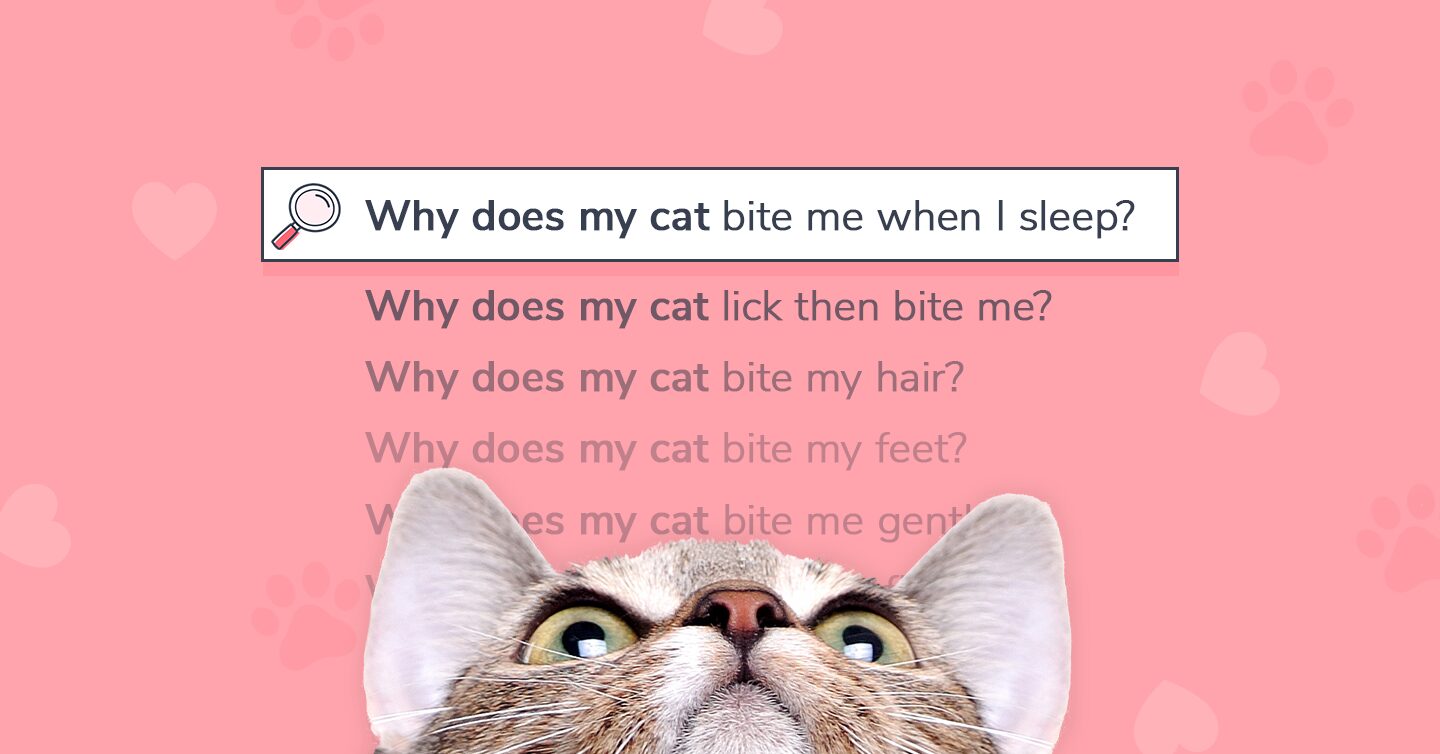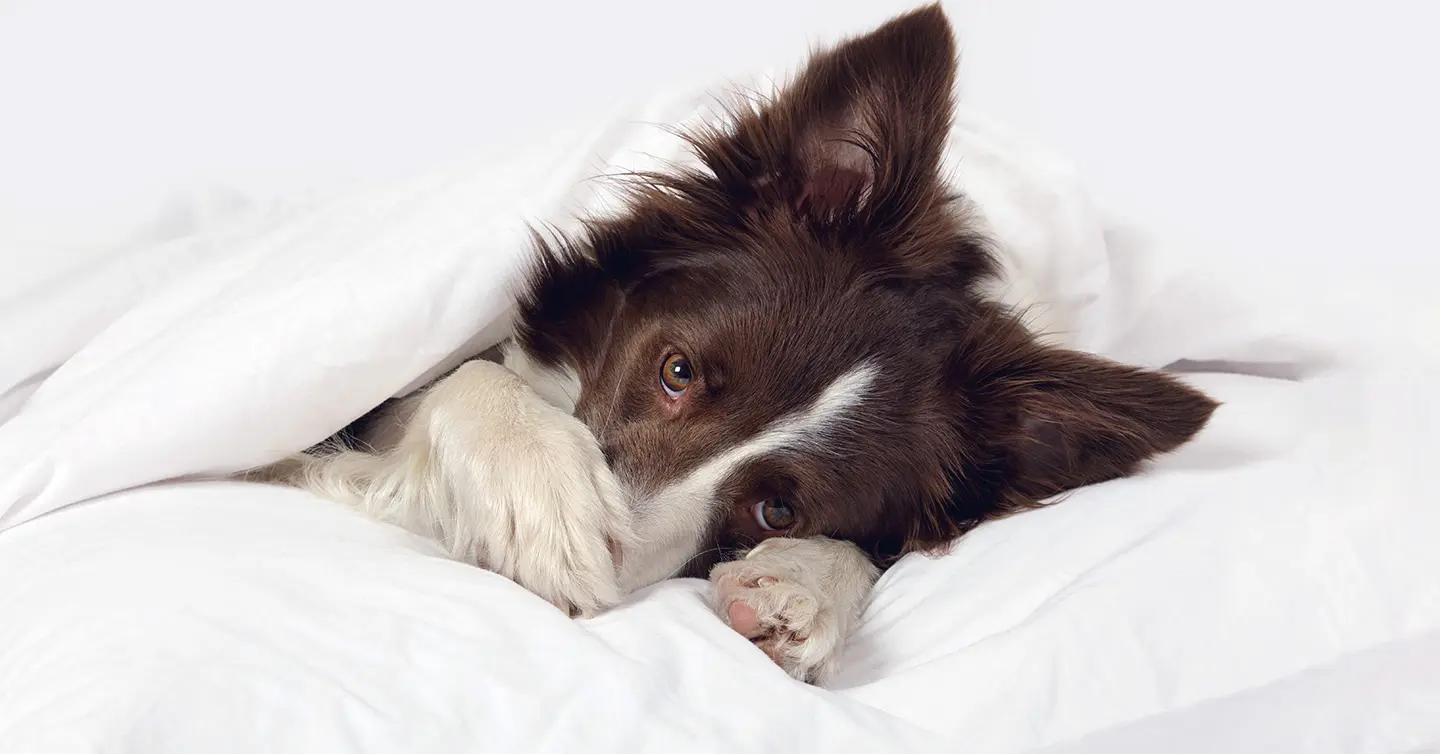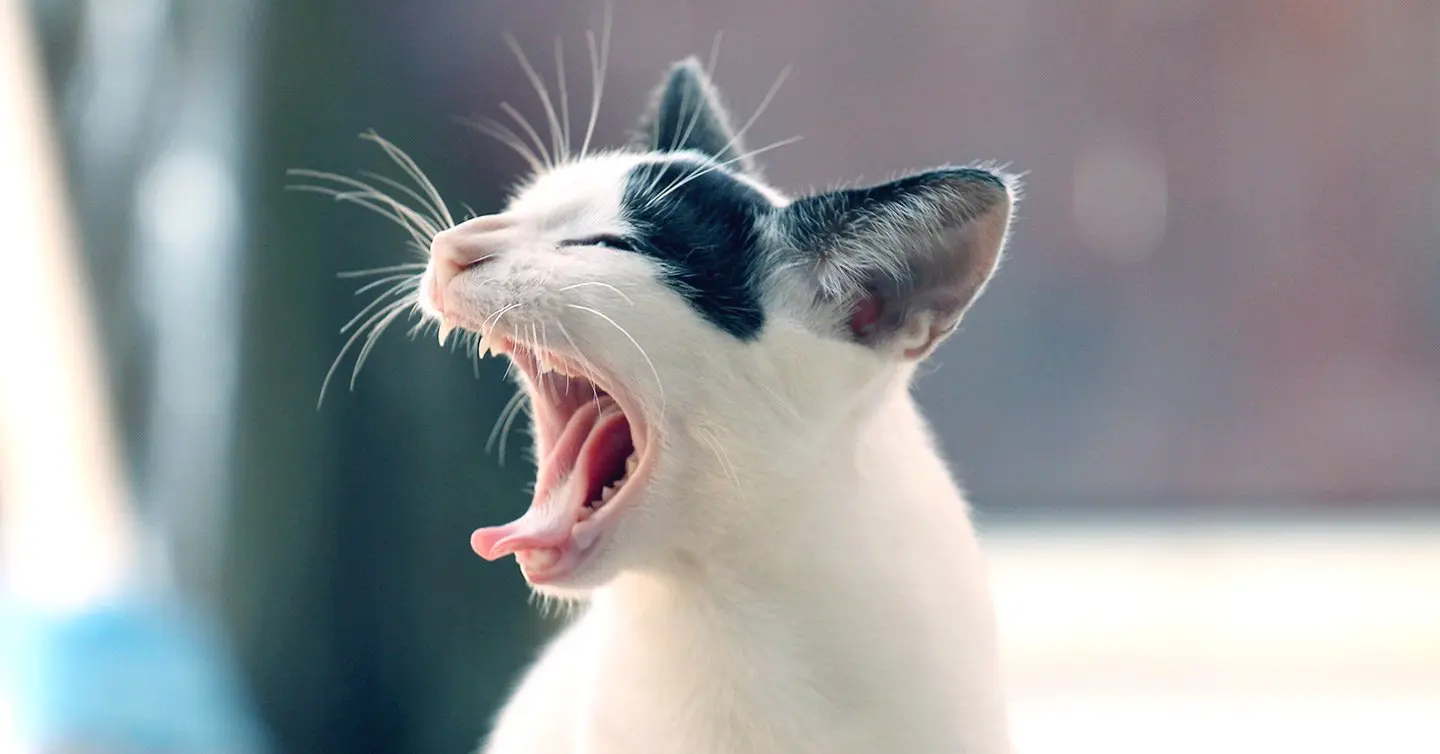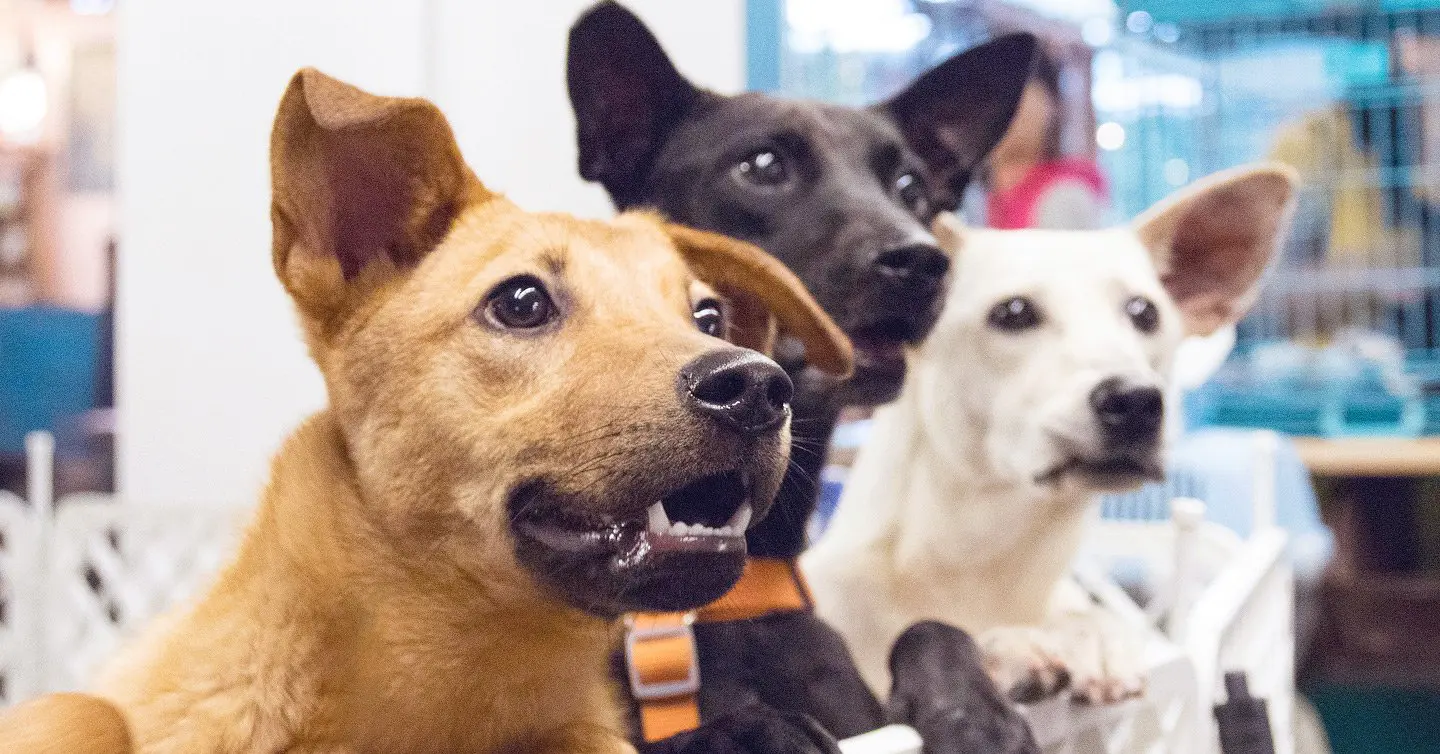Key Points
- Your cat’s behavior can be adorable (and often highly amusing). Meowing, staring, grooming, and biting are all ways that cats communicate with their owners.
- Cats are famously independent and aloof, which can make their behavior hard to read.
- If something feels off about your cat’s behavior, take them to the vet for a check-up.
For centuries, cats have won the hearts of humans around the world. Take a look through time — from ancient Egypt to internet memes — and you’ll see that humans have always been fascinated by cat behavior.
Purring, meowing, kneading, grooming, and biting are all common cat behaviors, but they are also ways for them to communicate. But what exactly drives these actions? Chances are, if you have a question about one of your cat’s quirks (and if that question begins with, “Why does my cat…”), then you’re not the first cat parent to ask it.
Below, you’ll find answers to the top 13 most Googled questions from cat parents.
1. Why does my cat lick me?
On average, adult cats spend up to 50% of their waking hours grooming. This instinctual behavior demonstrates serenity, affection, and happiness.
Most often, cats lick themselves and others when all is well in their world and they feel calm, safe, and secure. Mother cats groom their offspring to clean and strengthen bonds with their kittens. Similarly, bonded cats often groom one another to express trust and endearment.
When your cat licks you, they’re demonstrating their love for you. It’s not typical for a cat to lick a human they don’t know very well, so consider a lick from your cat a special sign of respect and affection.
It’s also a way for them to mark their territory and spread their pheromones. Cats are territorial by nature and want other animals to know what belongs to them — and that includes their favorite humans.
Some cats will lick their owners because they like how they taste. This is especially true if your cat licks you after you’ve sweated, used a lotion or oil they like, or just had something tasty on your hands.
In rare cases, your cat may lick you due to an underlying medical issue that causes discomfort or anxiety. Overgrooming and licking could indicate that your cat is stressed, anxious, or bored — especially since grooming is a way for cats to self-soothe.
2. Why does my cat bite me?
Cats bite for many different reasons. A bite doesn’t always indicate anger or spite — so don’t take it personally if your cat gently nips you while petting them. Of course, if it’s an angry bite, you’ll usually be able to tell.
Here are some reasons your cat may bite you:
Overstimulation: Often, cats become overstimulated when being pet and instinctively bite to let their owners know they’ve had enough — a behavior known as petting aggression.
Stress or anxiety: Sometimes, emotions like stress or fear may also motivate cats to bite their owners. For example, moving homes may cause your cat to feel anxious, leading them to bite when approached.
Playing: Biting is also a hunting instinct, so cats bite during playtime. If you don’t want your cat to bite you while playing, try offering them an interactive toy as a distraction. When the teeth come out, stop engaging with them.
3. Why does my cat lick me then bite me?
When your cat first licks you and then bites you relatively hard, this is often a sign of irritation and overstimulation. It’s likely your cat’s way of showing you they’re unhappy with the interaction or in pain.
That said, if your cat licks you affectionately and then nibbles on you softly while looking at you, this could also indicate that they want to play. After all, most cats are playful and friendly towards people they like.
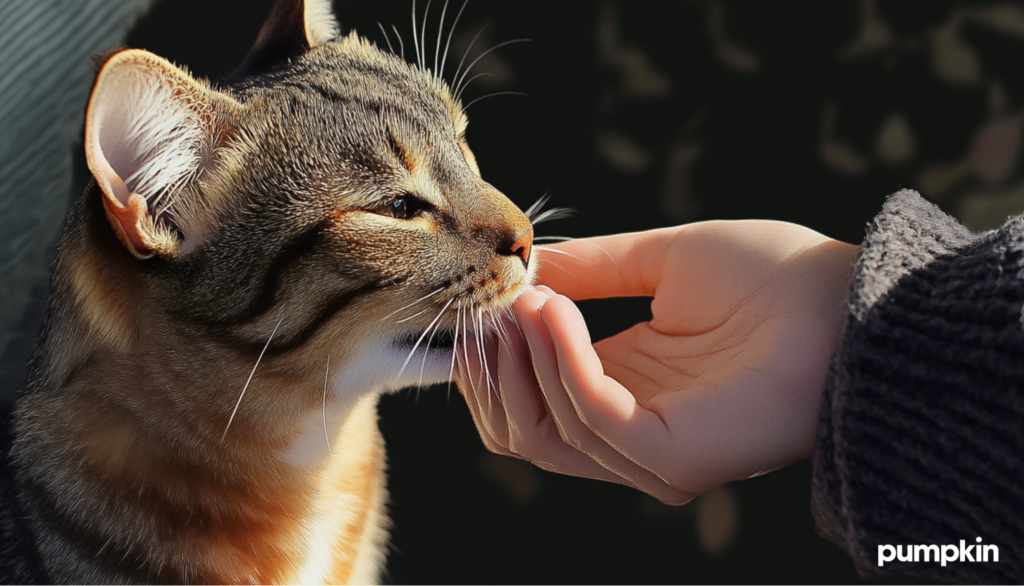
Yet another possibility is that your cat may be grooming you. Cats often lick their fur to groom themselves, biting it to get rid of tangles — meaning they could do the same to you.
So, it’s essential to consider the specifics of this situation.
4. Why does my cat stare at me?
When you catch your cat staring at you, you may wonder what’s running through their mind. Are they thinking about how much they love you, or plotting to take over the world?
When a cat holds eye contact with you, it’s a sign of respect and trust. In fact, slow blinking is a sign that your cat is happy and comfortable enough to close their eyes in your presence. In many ways, it’s a way for cats to say they love you.
According to certified cat behaviorist, Dr. Janet Cutler, staring can also be a sign of curiosity. “Your cat may be watching you to see what you’re going to do or how you’re feeling — they can tell the difference between a happy and an angry face,” she explains.
Conversely, your cat might stare at you because they’re angry or scared and want to let you know.
Read your cat’s body language to decipher what they’re trying to tell you with their stare. A calm disposition is often paired with relaxed ears and half-opened eyes, while a more anxious cat may seem tense or flick their tail back and forth.
5. Why does my cat meow so much?
Both kittens and adult cats meow to communicate their wants and needs and gain attention. You may notice that your cat is overly vocal whenever you return home, signifying their joy in seeing you — or perhaps letting you know to fill their food bowl.
Meowing can be a learned behavior for many cats, too. As Dr. Cutler explains, “Cats can meow because they’ve learned that gets them what they want.” If your cat’s meowing is becoming too much, she suggests you “stop rewarding them for meowing, and give them something in the moments they are quiet.”
Also, if your cat is in heat, you’ll likely notice that she’s more prone to meowing or yowling. This is her version of a mating call, and it’s a way to vocalize her current situation to any potential mates within earshot.
If your cat is not in heat, then excessive meowing could be a sign of distress, pain, or in older cats, hyperthyroidism. Listen carefully to the tone of their vocalizations. A chirp or purr can signify something very different from a loud yowl or distressed meow.
6. Why does my cat keep sneezing?
There’s typically no reason to worry about the occasional sneeze from your feline friend. But keep an eye out for odd patterns.
For example, if you notice they always sneeze after using their litter box, you may want to try changing litter brands, as your cat could have a litter allergy. Their food may also trigger sneezing if they have food allergies.
If your cat sneezes more than usual, it could indicate an upper respiratory infection or a dental tooth root infection. Upper respiratory infections are highly contagious and common in rescued or adopted cats.
If you think your cat may have food allergies, dental disease, an upper respiratory infection, or you’re just concerned about their sneezing, take them to the vet for treatment. For example, if your cat is suddenly and violently sneezing a lot, they could have a piece of grass stuck in their nose that needs to be removed by a veterinarian.
To help cover the costs of unexpected vet visits in the future, learn more about how Pumpkin Cat Insurance plans can make it easier to afford the best care for your whiskered companion.
7. Why does my cat sleep on me?
It’s no secret that cats love to sleep. And they aren’t picky with where they curl up, either. Cat owners can attest that cats love sleeping in many places, including in bed with their trusted human. Sometimes, they might try to curl up right on top of your face.
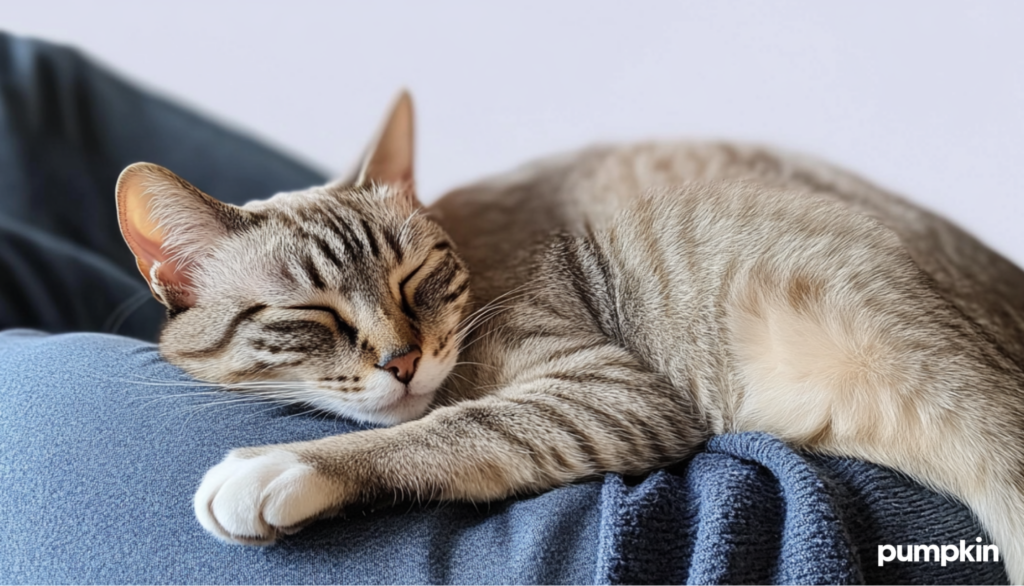
This makes sense when you look more closely at cat behavior. After all, bonded cats sleep together when they feel comfortable, happy, and (of course) sleepy. So, it’s natural that cats would enjoy sleeping with their owners, too.
Cats also love to snuggle up to heat sources, including their favorite humans’ body heat.
8. Why does my cat follow me everywhere?
Ever looked over your shoulder and wondered: Why is my cat following me around again?
Don’t worry — while this behavior may seem strange, your beloved kitty isn’t plotting anything devious. (We’re 99% sure of it.) When your cat becomes your shadow, it’s likely due to one of two simple reasons:
- They enjoy spending time with you
- They need food, water, or pets
Remember: cats are social creatures, too. When your furry little shadow follows you from room to room, they’re most likely just demonstrating a desire to be around you.
9. Why does my cat drool?
Cat drool usually signifies happiness and serenity, especially with purring or kneading. Some cats drool when they’re extremely content or calm — so don’t feel surprised if your cat starts drooling in their sleep, or during a particularly good petting session.
Excessive drooling is a different story, however. It can signify underlying issues such as dental disease, nausea, an upper respiratory infection, or extreme stress. If you notice excessive drooling in your cat, take them to the vet for an oral exam.
10. Why does my cat knead me?
Very few cat behaviors are as endearing as biscuit-making, or kneading.
Kneading is an instinctual behavior that starts in kittenhood. Kittens often knead their mothers while nursing or sleeping to demonstrate love, affection, and tranquility. This is a common behavior in all cats, including the big cats of the wild. However, domesticated cats will continue kneading their entire lives.
Older cats and senior cats are also avid biscuit makers. No matter their age, cats knead their owners because they feel safe, secure, and loved.
You may notice that your cat kneads you during a calming petting session, or right before they settle down for a nap on your lap. Kneading is also a way for cats to express the scent glands in their paws and mark their territory — so when your cat kneads you, they’re making it known that you’re their person.
11. Why does my cat headbutt me?
Like kneading, headbutting is a way for cats to spread their pheromones, mark their territory, and bond with their owners.
Cats also headbutt their humans to communicate love or a desire for pets and attention. So, if your kitty headbutts you out of nowhere, they may be asking for a nice head rub or cuddle session.
More than anything, headbutts mean your cat is proud to call you their parent. As Dr. Cutler puts it, “Bunting (pushing their head up against you) is often a sign of affection and your cat being happy. Usually, this means they want to interact or get a pet, so use it as a sign to spend some time with them.”
12. Why does my cat pee on my bed?
Usually, cats don’t urinate outside the litter box out of anger. Instead, if your cat is urinating on your bed, it’s likely due to a medical condition or because they’re experiencing stress or anxiety:
- Medical condition: Your cat may have a urinary tract infection (meaning they can’t hold it long enough to reach the litter box).
- Stress or anxiety: On the other hand, urine marking (including spraying and inappropriate urination) is one of the most common cat behavior problems and is a way for cats to cope with stress.
Your veterinarian can address both of these issues. But, depending on the severity of your cat’s urine marking issue, you may require additional help from a cat behaviorist.
13. Why does my cat keep throwing up?
There are many different reasons why your feline friend may be vomiting a lot, ranging from intestinal blockage to internal parasites. Cats sometimes nibble on plants like cat grass to make themselves vomit, and it’s believed this behavior helps cats get rid of parasites and indigestible material like hair and bones. Try directing your kitty away from your indoor plants if they’re eating plants and throwing up.
Make sure you’re feeding them a proper diet. If you’re feeding your cat the wrong food, or indulging them with too much human food (especially carbs or treats), decrease the amount or remove these foods altogether.
If this doesn’t work, your cat may have an internal parasite or other medical condition, and you should take them to the vet for diagnosis and treatment.
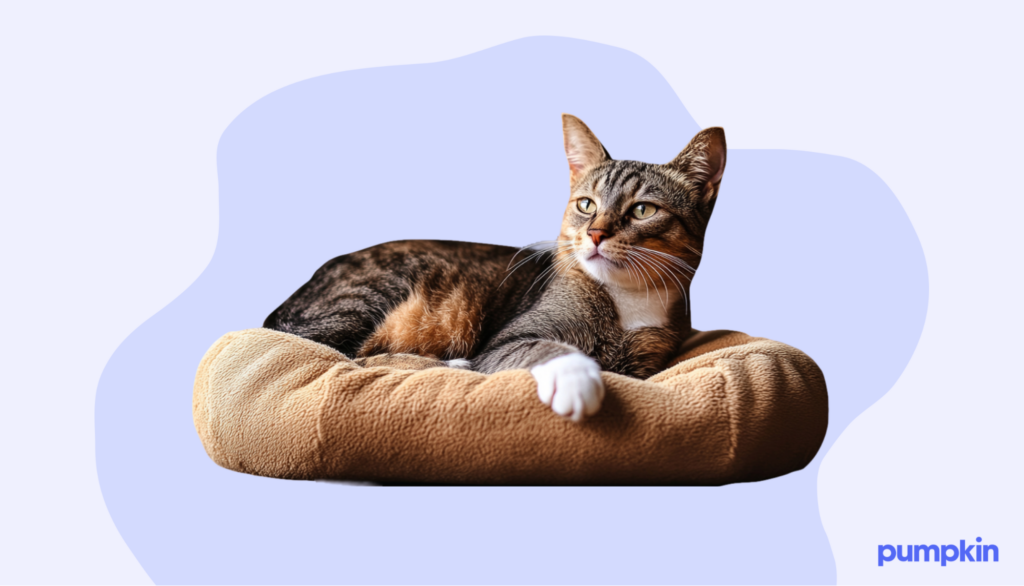
How to read your cat’s mood
If you’re wondering how your cat feels at any moment, their body language can often be a dead giveaway. Here are some common body language indicators for your cat’s mood:
- Relaxed and happy: Your cat will likely lie or sit comfortably, often with half-closed eyes (looking as relaxed as possible). You might even hear some soft purring or notice kneading.
- Energetic and playful: When your cat is in the mood to play, they’ll likely have perked ears and quick, darting movements. If you look closely, you may even see dilated pupils.
- Annoyed and overstimulated: If your cat is turning their head away from you and flattening their ears, this is a sign that they’ve had enough. They may even swipe or give you a light bite to show their irritation.
- Anxious and uneasy: Signs of anxiety in your cat include wide eyes, ears pointing sideways, and crouching or a low posture. They may even hide away or look like they want to run for safety.
- Scared or startled: A scared cat usually has an arched back and puffed-up tail. They may also hiss, bare their teeth, or growl.
- Aggressive and angry: An angry cat behaves much like a scared and annoyed cat. They have flattened ears, a rigid stance, and may growl or lash out aggressively.
Learn to read your cat’s quirks
Happy cats communicate love and trust in various ways, such as kneading, purring, staring, following, licking, and head-tapping their owners. These are all normal behaviors for our kitties.
If something ever feels off about your cat’s behavior, take them to the vet for a professional exam. Better yet, take them for yearly check-ups to ensure they remain healthy and happy and to catch any potential issues early.
- https://mymodernmet.com/cats-in-ancient-egyptian-art/
- https://www.vet.cornell.edu/departments-centers-and-institutes/cornell-feline-health-center/health-information/feline-health-topics/cats-lick-too-much
- https://spca.bc.ca/news/ask-spca-cat-petting-aggression/
- https://www.purina.co.uk/articles/cats/behaviour/training/stop-cats-biting
- https://www.nidirect.gov.uk/articles/welfare-cats-normal-behaviour-patterns
- https://bestfriends.org/pet-care-resources/what-do-cat-slow-blinks-mean
- https://cat-world.com/team/janet-cutler-phd/
- https://www.vet.cornell.edu/departments-centers-and-institutes/cornell-feline-health-center/health-information/feline-health-topics/respiratory-infections
- https://www.trupanion.com/pet-blog/article/how-to-tell-if-cats-are-bonded
- https://www.petmd.com/cat/nutrition/cat-nutrition-what-makes-nutritional-cat-food
